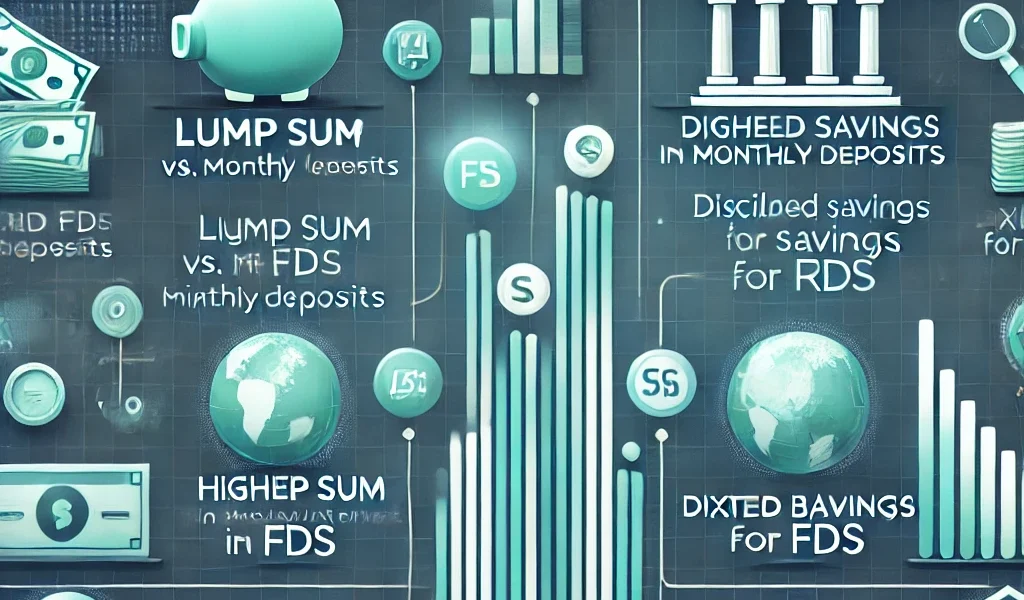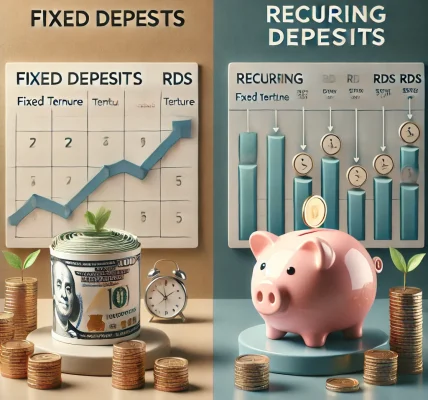When it comes to secure and reliable saving options, Fixed Deposits (FDs) and Recurring Deposits (RDs) are two of the most popular choices. Both offer guaranteed returns and are suitable for individuals looking for low-risk investments. However, they differ in terms of deposit structure, interest rates, liquidity, and flexibility.
In this detailed guide, we will compare Fixed Deposits and Recurring Deposits to help you determine which one suits your savings strategy better.
Understanding Fixed Deposits (FDs)
A Fixed Deposit (FD) is a savings instrument where an individual deposits a lump sum amount for a fixed tenure at a predetermined interest rate. The money remains locked for the chosen period, and interest is earned until maturity.
Key Features of Fixed Deposits:
- One-time deposit for a fixed tenure.
- Interest rate is higher than regular savings accounts.
- Flexible tenure ranging from 7 days to 10 years.
- Premature withdrawal is allowed with a penalty.
- Tax-saving FDs come with a 5-year lock-in period.
Advantages of Fixed Deposits:
- Guaranteed Returns: Interest rates remain constant throughout the tenure, ensuring stable returns.
- Higher Interest Rates: FDs typically offer higher interest rates than savings accounts and RDs.
- Low Risk: Since FDs are not market-linked, they are safe and secure.
- Flexible Investment Period: Investors can choose tenures based on their financial goals.
- Tax Benefits: Tax-saving FDs provide deductions under Section 80C of the Income Tax Act.
Understanding Recurring Deposits (RDs)
A Recurring Deposit (RD) is a disciplined savings option where an individual deposits a fixed amount every month for a predetermined period. Interest is earned on these deposits, and the total amount (principal + interest) is paid at maturity.
Key Features of Recurring Deposits:
- Regular monthly deposits instead of a lump sum.
- Tenure typically ranges from 6 months to 10 years.
- Interest rates are similar to Fixed Deposits but may vary slightly.
- Premature withdrawal is possible, but with a penalty.
- Ideal for salaried individuals and those with a steady income.
Advantages of Recurring Deposits:
- Encourages Regular Savings: Suitable for individuals who want to develop a disciplined saving habit.
- Fixed Interest Rate: Returns are stable as interest rates are predetermined.
- Low Initial Investment: Investors can start with a small deposit amount, making it accessible to all income groups.
- Flexible Tenure Options: Individuals can choose tenures based on their financial objectives.
- Safe Investment: Since RDs are not linked to the stock market, they are low-risk investments.
Fixed Deposits vs. Recurring Deposits: Key Differences
| Feature | Fixed Deposits (FD) | Recurring Deposits (RD) |
|---|---|---|
| Deposit Mode | Lump sum deposit | Monthly fixed deposits |
| Interest Rate | Slightly higher than RDs | Similar to FDs but slightly lower |
| Tenure Range | 7 days to 10 years | 6 months to 10 years |
| Risk Factor | Low risk | Low risk |
| Liquidity | Premature withdrawal allowed (with penalty) | Premature withdrawal allowed (with penalty) |
| Tax Benefits | Tax-saving FDs under Section 80C | No specific tax benefits |
| Best For | Individuals with surplus funds looking for higher returns | Individuals looking for disciplined savings |
Which One Should You Choose?
Choose Fixed Deposits If:
✅ You have a lump sum amount to invest. ✅ You want to earn higher interest with low risk. ✅ You prefer long-term investments. ✅ You want to benefit from tax-saving options.
Choose Recurring Deposits If:
✅ You prefer to save small amounts regularly. ✅ You have a steady income and want a disciplined savings habit. ✅ You need flexibility in choosing the tenure. ✅ You want safe, predictable returns without investing a large amount upfront.
Tax Implications of FDs and RDs
- Fixed Deposits: Interest earned on FDs is taxable under “Income from Other Sources.” If the interest exceeds ₹40,000 (₹50,000 for senior citizens) in a financial year, TDS (Tax Deducted at Source) is applicable at 10%.
- Recurring Deposits: Interest earned on RDs is also taxable as per the investor’s income tax slab. Unlike FDs, TDS is not deducted on RDs, but interest must be declared in income tax returns.
Final Verdict: Which is the Better Saving Plan?
Both Fixed Deposits (FDs) and Recurring Deposits (RDs) are excellent saving options, but the choice depends on individual financial goals.
- If you have a lump sum amount and want to maximize your returns over a fixed period, a Fixed Deposit is the better option.
- If you prefer small, disciplined savings every month, a Recurring Deposit is more suitable.
For individuals seeking long-term wealth accumulation, a combination of both FDs and RDs can also be an effective strategy.
Conclusion
Both Fixed Deposits and Recurring Deposits offer secure, risk-free ways to grow savings. The right choice depends on your financial situation, savings goals, and investment capacity. Understanding the differences and benefits of each will help you make an informed decision for a financially secure future.
Let us know in the comments – Which saving plan suits your needs better? 🚀



